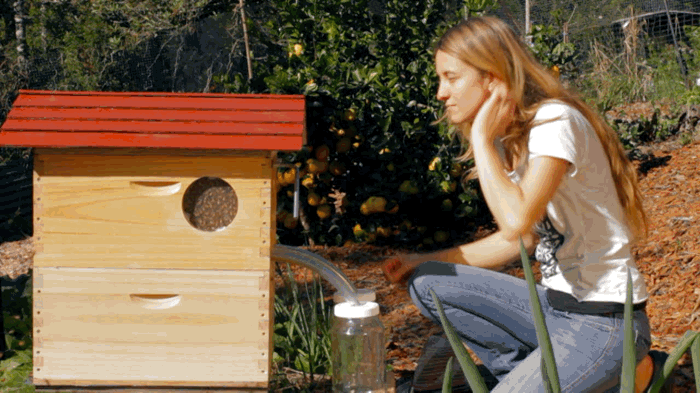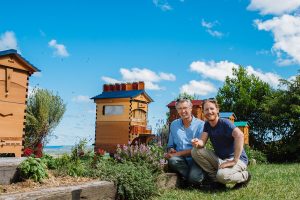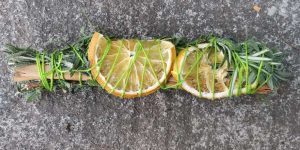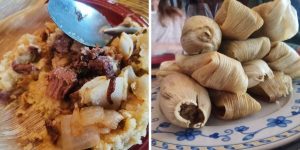In 2015, Flow Hive became a household name when Australian father-son inventing team Stuart and Cedar Anderson, unleashed their revolutionary honey-harvesting invention, and thousands of people pledged to bring their dreams of “honey on tap” to life.
Now, three years and some 51,000 units later, they are ready to launch Flow Hive 2, a redesign of the Flow Hive Classic, with 14 new innovations, all designed to improve the beekeeping experience and make the Flow honey harvesting system even easier on both the bees and the beekeeper alike.
The new hive is being sold by pre-order on Indiegogo, the crowdfunding site where the beekeeping phenomenon launched and attracted US$12.3 million in funding. To view the Indiegogo page, including a video walk-through of the new features, visit www.honeyflow.com/flowhive2

The new model marks an exciting milestone for Flow as Flow Hive 2 is the first to be manufactured all on home turf, on the NSW north coast, in Flow’s own facility.
Even more exciting for the Andersons, history is repeating itself with the launch of the new Flow Hive. During the crowdfunding phase, Cedar’s partner, Kylie Ezart, gave birth to their first child, Jarli. In the lead-up to the launch of Flow Hive 2, there has been a new addition to the brood, baby girl, Mella.
“They’re both packed with lots of great features,” Cedar says. “But I think in future we’ll try to avoid launching new products and new children at the same time. It gets pretty hectic.”
But the launch of Flow Hive 2 is a far cry from the frenzy of 2015. Since then, the company has matured into a thriving start-up success story, with multiple prestigious awards to its credit, and smooth manufacturing and logistics in place to service customers in more than 130 countries.
Flow Frames, the award-winning component which distinguishes a Flow Hive from a conventional Langstroth hive, provides bees with a partially fabricated honeycomb matrix which they complete with their own natural wax. When the honey cells are capped, the honey is ready.
Conventional honey harvesting involves opening the hive super (the top box where the honey is), levering out the frames and carrying them to a honey shed or kitchen. Then the caps must be cut off with a hot knife, then the honey squeezed or spun out using a centrifugal extractor. It’s a hot, sticky, messy business involving lots of heavy lifting and plenty of bee stings.
But with a Flow Hive, the beekeeper can, from outside the hive, simply insert a tool into the frame and turn, activating the mechanism. The honey cells split vertically and the hexagons form channels, allowing the honey to flow down into the trough and out into the jar. It’s fresh, pure, totally untreated honey on tap without even the need to filter.
Feedback for the game-changing invention has been overwhelmingly positive and a global community has sprung up around the invention, leading to an estimated 10 percent increase in the number of backyard beekeepers in the US and, according to ABC News, sharp upticks in beekeeping club memberships in Australia.
 “We’re really pleased by how we’ve been able to not only bring about a resurgence in beekeeping, but an interest in responsible stewardship. Bees are fascinating creatures and the honey is really just the sweet reward for taking really good care of them,” Cedar says.
“We’re really pleased by how we’ve been able to not only bring about a resurgence in beekeeping, but an interest in responsible stewardship. Bees are fascinating creatures and the honey is really just the sweet reward for taking really good care of them,” Cedar says.
Having such a strong and engaged community has allowed the company to look beyond the bottom line, with bee advocacy and pollinator education an increasing part of the work they do.
“This has all come about because of our love for the bees and an acknowledgement of how important they are, not only to the food we eat, but to all life on Earth,” Stu says. “If we look after them, they’ll look after us.”
The company is putting its money where its mouth is. Late last year, Flow launched a limited edition “pollinator house”. Made from bamboo and upcycled timber off-cuts from the creation of Flow Hives, and designed as homes for solitary and native bees, 800 units sold out in just days. All of the profits will be released later in the year to fund initiatives that support habitat for pollinators.
Watch a video of the Flow Hive 2 in action!
Check out the article on Steemit.com: https://steemit.com/homesteading/@homestead-guru/flow-hive-2-has-arrived-as-crowdfunding-sensation-turns-three





